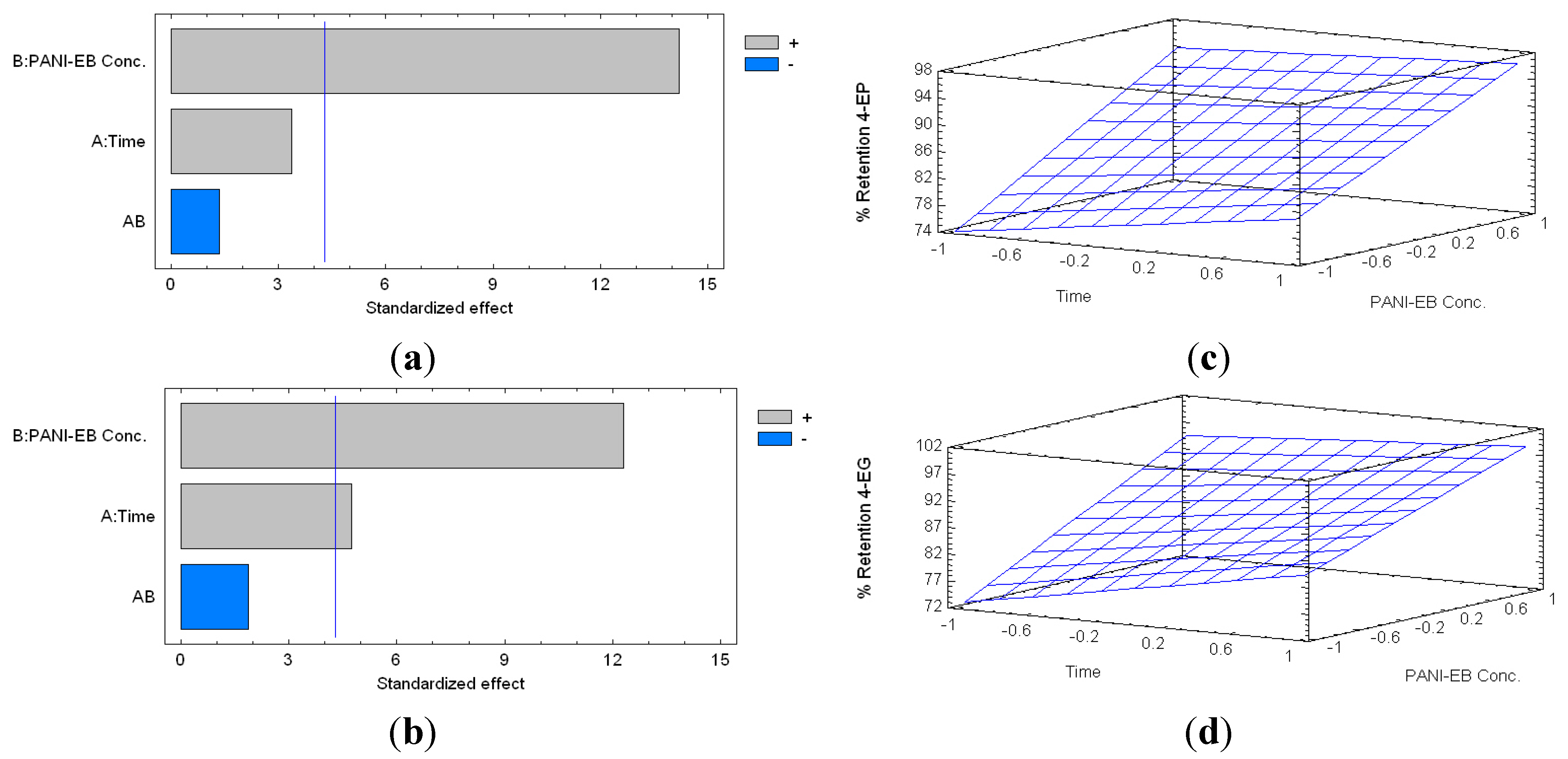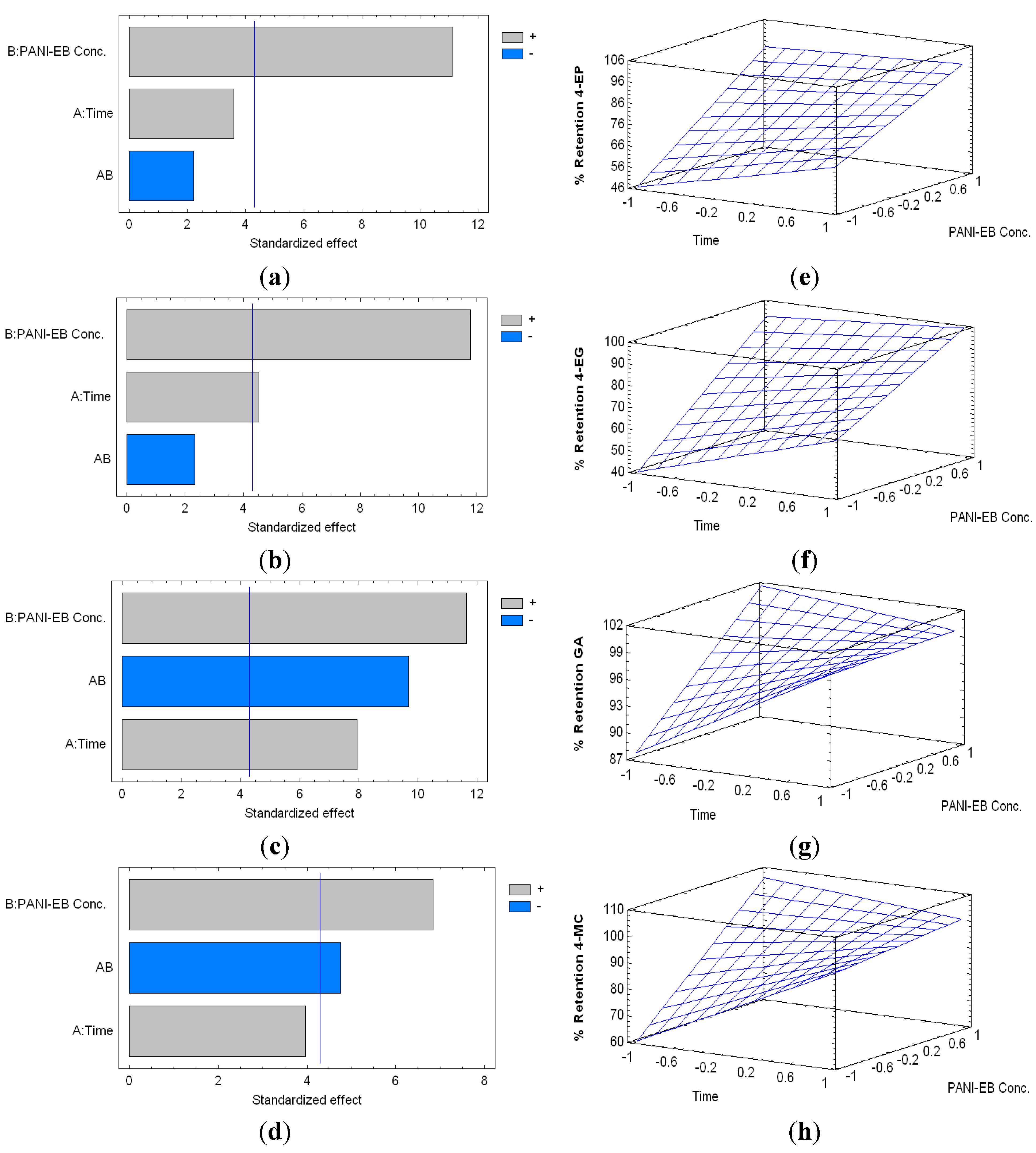Removal of 4-Ethylphenol and 4-Ethylguaiacol with Polyaniline-Based Compounds in Wine-Like Model Solutions and Red Wine
Abstract
:1. Introduction

2. Results and Discussion
2.1. PANI Affinity for 4-EP and 4-EG in Wine-Like Model Solution


2.2. The Ability of PANI Polymers to Remove 4-EP and 4-EG from Wine-Like Model Solutions Containing Gallic Acid and 4-Methylcatechol

2.3. The Affinity of PANI Polymers towards 4-EG and 4-EP in Red Wine

| PANI Dose [mg·mL−1] | 4-EP Concentration [mg·L−1] | 4-EG Concentration [mg·L−1] | Total Phenolics [g·L−1] | |||
|---|---|---|---|---|---|---|
| PANI-ES | PANI-EB | PANI-ES | PANI-EB | PANI-ES | PANI-EB | |
| 0 | 5.00 ± 0.06 i | 5.00 ± 0.06 i | 5.00 ± 0.04 g | 5.00 ± 0.04 g | 2.03 ± 0.02 f | 2.03 ± 0.02 f |
| 10 | 4.65 ± 0.03 h | 1.61 ± 0.02 e | 4.81 ± 0.12 g | 2.55 ± 0.07 d | 1.60 ± 0.06 e | 1.19 ± 0.04 d |
| 25 | 4.12 ± 0.02 g | 0.86 ± 0.01 c | 3.56 ± 0.01 f | 1.00 ± 0.02 b | 1.16 ± 0.05 d | 0.29 ± 0.06 b |
| 50 | 1.95 ± 0.04 f | 0.320 ± 0.001 b | 3.35 ± 0.01 e | 0.37 ± 0.05 a | 0.45 ± 0.03 c | 0.22 ± 0.02 b |
| 100 | 1.08 ± 0.01 d | 0.000 ± 0.001 a | 1.70 ± 0.15 c | 0.29 ± 0.03 a | 0.10 ± 0.02 a | 0.0010 ± 0.0002 a |
3. Experimental Section
3.1. Chemical Reagents
3.2. Synthesis and Characterization of PANI Polymers
3.3. The Affinity of PANI Polymers towards 4-EP and 4-EG in Model Solution
3.4. The Ability of PANI Polymers to Remove 4-EP and 4-EG from Wine-Like Model Solutions Containing Gallic Acid and 4-Methylcatechol
3.5. The Affinity of PANI Polymers towards 4-EP, 4-EG and Total Phenolics in Red Wine
3.6. Analyses of 4-EP, 4-EG and Phenolic Compounds in Model Solutions and Red Wine
3.6.1. Extraction of 4-EP and 4-EG
3.6.2. Liquid Chromatography Analyses
3.6.3. Total Phenolic Content
3.7. Experimental Design and Statistical Analyses
4. Conclusions
Acknowledgments
Author Contributions
Conflicts of Interest
References
- Chatonnet, P.; Dubordieu, D.; Boidron, J. The influence of Dekkera/Brettanomyces sp. yeast and lactic acid bacteria on the ethylphenol content of red wines. Am. J. Enol. Vitic. 1995, 46, 463–468. [Google Scholar]
- Edlin, D.A.N.; Narbad, A.; Gasson, M.J.; Dickinson, J.R.; Lloyd, D. Purification and characterization of hydroxycinnamate decarboxylase from Brettanomyces anomalus. Enzyme Microb. Technol. 1998, 22, 232–239. [Google Scholar] [CrossRef]
- Dias, L.; Dias, S.; Sancho, T.; Stender, H.; Querol, A.; Malfeito-Ferreira, M.; Loureiro, V. Identification of yeasts isolated from wine-related environments and capable of producing 4-ethylphenol. Food Microbiol. 2003, 20, 567–574. [Google Scholar] [CrossRef]
- Tchobanov, I.; Gal, L.; Guilloux-Benatier, M.; Remize, F.; Nardi, T.; Guzzo, J.; Serpaggi, V.; Alexandre, H. Partial vinylphenol reductase purification and characterization from Brettanomyces bruxellensis. FEMS Microbiol. Lett. 2008, 284, 213–217. [Google Scholar] [CrossRef] [PubMed]
- Godoy, L.; Martínez, C.; Carrasco, N.; Ganga, M.A. Purification and characterization of a p-coumarate decarboxylase and a vinylphenol reductase from Brettanomyces bruxellensis. Int. J. Food Microbiol. 2008, 127, 6–11. [Google Scholar] [CrossRef] [PubMed]
- De Rosso, A.; Panighel, A.; Dalla Vedova, L.; Stella, R.; Flamini, J. Changes in chemical composition of a red wine aged in acacia, cherry, chestnut, mulberry, and oak wood barrels. Agric. Food Chem. 2009, 57, 1915–1920. [Google Scholar] [CrossRef] [PubMed]
- Caboni, P.; Sarais, G.; Cabras, M.; Angioni, A. Determination of 4-ethylphenol and 4-ethylguaiacol in wines by LC-MS-MS and HPLC-DAD-fluorescence. J. Agric. Food Chem. 2007, 55, 7288–7293. [Google Scholar] [CrossRef] [PubMed]
- Pizarro, C.; Sáenz-González, C.; Pérez-del-Notario, N.; González-Sáiz, J.M. Development of a dispersive liquid-liquid microextraction method for the simultaneous determination of the main compounds causing cork taint and Brett character in wines using gas chromatography-tandem mass spectrometry. J. Chromatogr. A 2011, 1218, 1576–1584. [Google Scholar] [CrossRef] [PubMed]
- Romano, A.; Perello, M.C.; de Revel, G.; Lonvaud-Funel, A. Growth and volatile compound production by Brettanomyces bruxellensis in red wine. J. Appl. Microbiol. 2008, 104, 1577–1585. [Google Scholar] [CrossRef] [PubMed]
- Ugarte, P.; Agosin, E.; Bordeu, E.; Villalobos, J.I. Reduction of 4-ethylphenol and 4-ethylguaiacol concentration in red wines using reverse osmosis and adsorption. Am. J. Enol. Viticult. 2005, 56, 30–36. [Google Scholar]
- Chassagne, D.; Guilloux-Benatier, M.; Alexandre, H.; Voilley, A. Sorption of wine volatile phenols by yeast lees. Food Chem. 2005, 91, 39–44. [Google Scholar] [CrossRef]
- Pradelles, R.; Alexandre, H.; Ortiz-Julien, A.; Chassagne, D. Effects of yeast cell-wall characteristics on 4-ethylphenol sorption capacity in model wine. J. Agric. Food Chem. 2008, 56, 11854–11861. [Google Scholar] [CrossRef] [PubMed]
- Pradelles, R.; Vichi, S.; Alexandre, H.; Chassagne, D. Influence of the drying processes of yeasts on their volatile phenol sorption capacity in model wine. Int. J. Food Microbiol. 2009, 135, 152–157. [Google Scholar] [CrossRef] [PubMed]
- Garde-Cerdán, T.; Zalacain, A.; Lorenzo, C.; Alonso, J.L.; Rosario-Salinas, M. Molecularly imprinted polymer-assisted simple clean-up of 2,4,6- trichloroanisole and ethylphenols from aged red wines. Am. J. Enol. Vitic. 2008, 59, 396–400. [Google Scholar]
- Larcher, R.; Puecher, C.; Rohregger, S.; Malacarne, M.; Nicolini, G. 4-ethylphenol and 4-ethylguaiacol depletion in wine using esterified cellulose. Food Chem. 2012, 132, 2126–2130. [Google Scholar] [CrossRef]
- Bhadraa, S.; Khastgir, D.; Singha, N.K.; Lee, J.H. Progress in preparation, processing and applications of polyaniline. Progr. Polym. Sci. 2009, 34, 783–810. [Google Scholar] [CrossRef]
- Palaniappan, S.; John, A. Polyaniline materials by emulsion polymerization pathway. Prog. Polym. Sci. 2008, 33, 732–758. [Google Scholar] [CrossRef]
- Marican, A.; Carrasco-Sánchez, V.; John, A.; Laurie, V.F.; Santos, L.S. The binding of 4-ethylguaiacol with polyaniline-based materials in wine. Food Chem. 2014, 159, 486–492. [Google Scholar] [CrossRef] [PubMed]
- Santos, L.S.; Laurie, V.F.; Amalraj, J.; Carrasco-Sánchez, V.; Nachtigall, F. Toxic Phenolic Compound Removal by Selective Binding of Phenolic Compounds Using Smart Polymers. U.S. Patent 8 927 042, 6 January 2015. [Google Scholar]
- Ashley, P.C.; Joseph, M.J.; Mohanan, P.V. Activity of diastase α-amylase immobilized on polyanilines (PANIs). Food Chem. 2011, 127, 1808–1813. [Google Scholar] [CrossRef]
- Cao, Y.; Smith, P. Liquid-crystalline solutions of electrically conducting polyaniline. Polymer 1993, 34, 3139–3143. [Google Scholar] [CrossRef]
- Palaniappan, S.; John, A.; Amarnath, C.A.; Rao, V.J. Mannich-type reaction in solvent free condition using reusable polyaniline catalyst. J. Mol. Catal. A Chem. 2004, 218, 47–53. [Google Scholar] [CrossRef]
- Dallas, C.; Ricardo-da-Silva, J.M.; Laureano, O. Interactions of oligomeric procyanidins in model wine solutions containing malvidin-3-glucoside and acetaldehyde. J. Agric. Food. Chem. 1996, 70, 493–500. [Google Scholar] [CrossRef]
- Elias, R.J.; Laurie, V.F.; Ebeler, S.E.; Wong, J.W.; Waterhouse, A.L. Analysis of selected carbonyl oxidation products in wine by liquid chromatography with diode array detection. Anal. Chim. Acta 2008, 626, 104–110. [Google Scholar] [CrossRef] [PubMed]
- Lambropoulos, I.; Roussis, I. Inhibition of the decrease of volatile esters and terpenes during storage of a white wine and a model wine medium by caffeic acid and gallic acid. Food Res. Int. 2007, 40, 176–181. [Google Scholar] [CrossRef]
- Valente, I.M.; Santos, C.M.; Moreira, M.M.; Rodrigues, J.A. New application of the QuEChERS methodology for the determination of volatile phenols in beverages by liquid chromatography. J. Chromatogr. A 2013, 1271, 27–32. [Google Scholar] [CrossRef] [PubMed]
- Singleton, V.L.; Orthofer, R.; Lamuela-Raventós, R.M. Analysis of total phenols and other oxidation substrates and antioxidants by means of Folin-Ciocalteu reagent. Methods Enzymol. 1999, 299, 152–178. [Google Scholar]
- Sample Availability: Samples of the compounds PANI-EB and PANI-ES are available from the authors.
© 2015 by the authors. Licensee MDPI, Basel, Switzerland. This article is an open access article distributed under the terms and conditions of the Creative Commons Attribution license ( http://creativecommons.org/licenses/by/4.0/).
Share and Cite
Carrasco-Sánchez, V.; John, A.; Marican, A.; Santos, L.S.; Laurie, V.F. Removal of 4-Ethylphenol and 4-Ethylguaiacol with Polyaniline-Based Compounds in Wine-Like Model Solutions and Red Wine. Molecules 2015, 20, 14312-14325. https://doi.org/10.3390/molecules200814312
Carrasco-Sánchez V, John A, Marican A, Santos LS, Laurie VF. Removal of 4-Ethylphenol and 4-Ethylguaiacol with Polyaniline-Based Compounds in Wine-Like Model Solutions and Red Wine. Molecules. 2015; 20(8):14312-14325. https://doi.org/10.3390/molecules200814312
Chicago/Turabian StyleCarrasco-Sánchez, Verónica, Amalraj John, Adolfo Marican, Leonardo S. Santos, and V. Felipe Laurie. 2015. "Removal of 4-Ethylphenol and 4-Ethylguaiacol with Polyaniline-Based Compounds in Wine-Like Model Solutions and Red Wine" Molecules 20, no. 8: 14312-14325. https://doi.org/10.3390/molecules200814312
APA StyleCarrasco-Sánchez, V., John, A., Marican, A., Santos, L. S., & Laurie, V. F. (2015). Removal of 4-Ethylphenol and 4-Ethylguaiacol with Polyaniline-Based Compounds in Wine-Like Model Solutions and Red Wine. Molecules, 20(8), 14312-14325. https://doi.org/10.3390/molecules200814312







